An Interview with Reiner Strasser about c.re.ations
with Marjorie Coverley Luesebrink
Reiner Strasser was born 1954 in Antwerpen, Belgium. He studied art, art history and
philosophy at the University of Mainz, Germany in the 70's.
His web works, international collaborations and web art projects date from 1996. His web
work appeared in several exhibitions/publications since 1997.
Most recently in the e-zinen: Riding the Meridian; Cauldron and Net; Beehive;
on several CD-ROM publications: The Little Magazine CD 22 Gravitational Intrigue,
University of Albany, NY, 1999; Dietsche Warande & Belfort, Elektronische
Literatuur, 4.99, NL/B; ALIRE 11, revue de littÈratur animÈ et
interactive, Mots-Voir, France, 2000; DOC(K)S "un notre web",
Corse 2000; and in real space: Aix Art Contemporaine Web en Provence, France,1999; Amour
et Conscience, art show in Paris, 1999; AJAC 25th Art Exhibition, Metropolitan Art Museum,
Tokyo, 1999; NOW Festival Nottingham, GB, 1999; AJAC 2000, M.A.M., Tokyo, 2000; INFOS '00
(honourable mention in the net art contest), Lubljana, Slovenia, 2000.
Reiner Strasser's on-line work has been intriguing the web-art community since 1997. His pared elegance of presentation, evocative graphics, and gentle humor always create a sense of confirmation and ongoing surprise. C.re.ations is the newest addition in the cumulous and accumulating site that Reiner explains he handles as "a self-developing system" that "will evolve as the net will evolve--human-made, creating a synthetic/organic structure." C.re.ations consists of new work, 1999-2000, including "vib~ratio~n", "the shrIne", "e[y]gg[e]", "structur/al walk", and "breathe."
MCL: Your work in c.re.ations represents both a continuation of the aesthetics of
earlier work in Re: and a venture into some new technologies. You have made excellent use
of movement in earlier pieces, with moving panels, animated .gifs, and dhtml. Does the use
of Flash change the poetics and aesthetics of your work in any way?
RS: I think i have to go back to the beginning of the Re.works to reply to this question.
In 1997, i was in close contact with Ted Warnell/PbN, i c.re.ated Re: as a kind of
virtual figure who wants to express itself in the language of the net. He or it, well i am
male, collects tools and creates with them. Normally you call this media-specific work.
From month to month the pool of tools grows. When looking at tools in a technical way
'Flash' is the last one. Generally i think there is no difference in the elements but in
the form they can be combined in Flash. The kind of transition can be smoother than in
dhtml, by opening new windows or loading
new content in frames. As i look at transitions as a form of expression, the language is
enhanced. But there is also another point. Last time i focus on time or
the experience of time in a piece (implementing filmic elements). Flash is a very
time-based--thought in a linear development of time--program. It is interesting for me to
go round, to by pass this handicap. And this handicap in the experience of a piece, the
aspect of linear narration is exactly the problem to handle in the creation of more
complex hypermedial pieces.
MCL: Yes, timing has always been important in both spoken and written poetry and
storytelling--and, as you say, Flash allows for greater control over the time sequence of
a piece, but it also is difficult to assure that the piece will be experienced at the same
rate by all readers. You say that this handicap is something to "go round" --
both technically and strategically. What methods allow a writer to "pass by" or
elide the time elements?
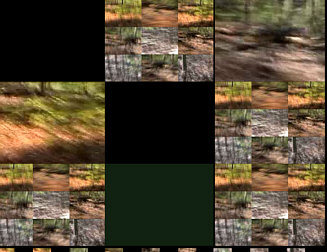
structur/al walk
RS: Yes, in Flash you have a better control over 'timing', ie. to synchronize picture
and sound, but it depends on the technical equipment whether this will be played in the
right speed. I am not breaking my head about this. Speed is increasing day by day (appr.
100% a year) therefore pieces done nowadays will be 'received' in the right timing
tomorrow. My experience in art, reception and creation, is that you have to give 1000% to
get 100%. Many aspects i have spent much time in elaborating are not recognized conciously
by the viewer but they 'help' to increase the expression of a piece. Therefore a loss of
exactness is not as important for the whole experience but may be seen as a 'lively'
completion. In my sight a net or hypermedial work is something else than a linear
construction. This becomes very obvious in the fact
that you give away the absolute control over time through the interactive discovery of the
work by the viewer. You create a 'spaceless' environment, an offer of choices and events.
I like to compare this with human thinking or my understanding of it. In reality you do
not think logically like in mathematics but you sort, arrange aspects out of a pool of
thoughts. It is much like living in the modern society where you collect information from
an immense offer of stimuli. You ask for methods to 'by pass' - might be the easiest way
is to forget the story (ha, sounds like a joke) at first and to built the story with the
elements you create.
MCL: The pieces collected in c.re.ations, and on your site as a whole, function
as both a gallery collection and as a kind of continuing discourse. Could you comment on
which elements you see as persistent, and which as unique to one piece or another?
RS: Oh, i never think about persistance, looking at my own stuff. Well it is made by
myself and i recognize that things repeat. There are variations of themes like 'vacancy'
... Looking at more formal aspects there is a slipping between two ways. The picture-like
pieces, plates/plateaus and the hyperlinked pieces. In my view the plateaus represent the
'infolding' way of expression, the hyperlinked the 'unfolding'
one. These are for me two contrasting ways to develop a piece but also of thinking
generally - how to handle complexity. You will find too the tension between 'word' -
'picture' - 'sound' and the interactive combination of it in many pieces. The fact that
the tools have grown from the beginning has changed the form of the pieces. At the same
time i want to integrate these elements closer. The pieces are all 'unique' - smile.
I could tell a story to every piece - collaboration or not.
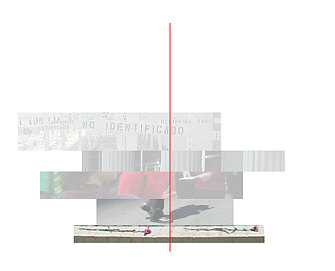
vib~ratio~n
MCL: You mentioned in one post that your work had been rejected at times, but on two
different grounds--once, that it was literature and not art, and another time on the basis
that it was art and not literature. How are you personally sorting out the difference
between the two, or are you?
RS: I think the common view is that (i trivialize here) literature is bound on written or
spoken words, while art is more visual. Visual element in literature become illustrations,
words in art 'signs'. Because i want to fuse the visual and literal elements - i am not
standing any more between these two chairs but i am somewhere else. I like both parts as
much that i at least do not want to degrade one of the two.
MCL: Many of the pieces in c.re.ations are collaborations, even, as in the case
of "vib~ratio~n" and "the shrine," with two other people. How do you
go about collaborating with artists across the world--and more importantly, what attracts
you to the process? What kind of "discovery" do you make in these
collaborations?
RS: Three questions in one ;) Fine. Collaboration happen. Sometimes i ask or am asked -
sometimes it is a creative re.action. It is simply wonderful to work with artist, poets
and writers all around the world. What attracts me most in the process of collaboration?
In a more general view it is that you 'serve' and 'are served' - sometimes at the same
time. That is for me the deeper sense of communication and life. Isn't it ... that the net
in its positive form has strenghtend the conciousness, the reflection on communication
itself - on the importance of communication in human life? I like the way you are inspired
in collaborations. It could happen that you get a 'contribution' that 'misunderstood' by
you opens new ways. I do not want to cook only in my own soup. ;) When looking at art as a
kind of expression, communication, a language collaborations are the logical result.
MCL: Would you care to discuss the difficulties that are inherent in collaborative pieces?
For example, I loved the Racoon piece that you did with Christy Sheffield
Sanford, but I noticed that it is not finished--is it difficult to bring closure from
a distance?
RS: I love the piece, too. I love it as it is. The first fact you have to recognize and
even more to realize is that every collaborator, should i say every human on the net (?),
has a real life with all his positive and negative sides. You have to respect this. You
can teach your tolerance. With the Racoon it was quite simple, i had no time to
continue the work on it and afterwards we focused on the water piece. Btw. i like
unfinished pieces (nonfinito) and sometimes i think you have to create more 'unfinished'
works on the Net because the Net is always unfinished in its fluidance and might be
'nonfinito' works are more true in a general sight, representing life.
I do not think that it is difficult to bring closure on the Net especially for a writer, a
master of the word (i am not;) but you are more or less limited to a 'mindy' level. What i
have written somehow to this? "Distance is more a question of comprehension than of
locale nearness." (When you want to hold someone in your arms the Net is
definitively the wrong space. ;)
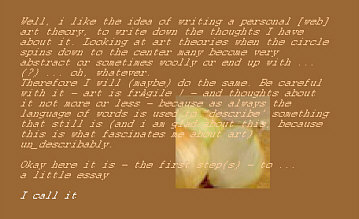
la cipolla
MCL: You suggest in "la cipolla" and elsewhere that the aesthetic of
layers is important to you as an artist, and that you believe the reader internalizes the
work in the act of peeling these layers. The "layers" effect seems to be very
strong in the pieces in c.re.ations. Is this the result of conscious evolution on
your part?
RS: It depend on my personal view on art. In my view art (visual or else) is polyvalent.
There are different layers to explore, conscious and unconsciously. That is where you as a
viewer has to be interactive. This coincidence to the construction of a net art piece is
very fascinating for me. But as mentioned in 'la cipolla' the transition or form
of transition is as important or more important than the layer itself because in this
transitions your mind begins to swing. In a more or less obvious form you may find it in
all of my pieces. Through the way you lead or the viewer goes from one layer to another
the pieces unfold. This aspect has a formal quality in the process of creation as it is a
model of thinking - complex thoughts expressed and generated by the cumulation of simple
parts.
MCL: The cumulation effect is always a source of richness in your work. Sometimes the
layers are enacted in a physical way, and other times the layering is a metaphorical
sedimentation of ideas. And, often, such as in "vib~ratio~n," the piece
does both concurrently. Do you plan these ahead of time, or do you experiment to see what
emerges?
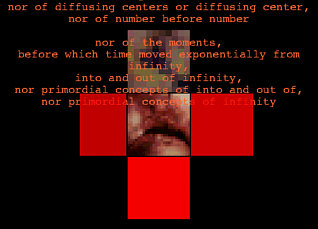
the shrIne
RS: Thinking in the layer model i 'see' two kinds of layers - the 'direct' and
'indirect' layers. The 'direct' layer (i prefer the german word: 'unmittelbar'), you
describe "enacted in a physical way", can be compared with the layers in a dhtml
page, but also with a new window, but this will become a bit misleading, because a sound
can form a layer, too. Layers can contain (imply) different stats in experience, like
emotions, concrete to abstract thoughts. The 'indirect' layer ('mittelbar' - i add the
german word here, too, because 'mittelbar' leads to 'vermittelbar' - 'to get someone
something' ) happens in the mind of the viewer in an associative way.
To come back to your question, it is a mixture of experiment, pure creation and
reflection. Let us take "vib~ratio~n". In "vib~ratio~n"
i worked with material, photos given by Bill Marsh (for his project). First i collected
details of the photos. What i am always looking for is a general meaning and
'polyvalence'.
That an element can get/obtain different meanings, from concrete to abstract, with some
conjunction to life. We are bound in life and discovering, expressing essence of life is
most interesting for me. With these photos i began to work in Flash. Oh, it will become
difficult to describe the whole process. Some more short notes on this piece. The first
version went to the trash. While working on the second one I changed some photos and
details of ... . Is it a decision planed or not? I think in the process you become part of
a piece and 'living' in it for a while you act without asking this question. You act
intuitively.
In combining 'polyvalent' elements you can create a more complex or more concrete
expression. The expression of simple parts, movements can change. One example: look at the
fluidance in the piece. The pictures appear at the beginning, the first picture 'the
crosses' - you might associate 'appearance - birth in contrast to death', 'fluidance -
breath - sea'. 'The crosses' themselves are associatable in different ways.... . It is
"vib~ratio~n".
MCL: Inherent in all of your answers is an emphasis on process. I have often thought that
the act of Net authoring is a "wet" medium, like water colors or glass blowing,
what happens depends on what happens. That is, as the piece is being made, new discoveries
show new potentialities. Can you comment on this?
RS: To use the notion process might become a bit misleading. Well as always it depends on
how you understand it. I think it implements that you really do not know (!) what it will
become, it is 'out of conscious control'. When thinking at 'water colour' (i have some
experience with this) i do not have a "wet" feeling (well it is wet;). You are
not painting by chance when you 'know' the medium. Surely you can create experimentally.
What happens when painting is that my mind changes. Coming back again to the virtual
figure Re:, which wants to express itself in the media. You are a writer and i think,
whenever you write, you do not ask for the how, but you write. I do not mean that it is
without reflection. But it happens because you have internalized the language (you are
grown up with ...).
That is especially the problem with new media. When working, in the process i have to
think in the language. Let us take the interactive sketches (in 1997/98). These have been
created as replies to mails. I (or Re:) wasn't able to express my thoughts/feelings with
words, therefore i created these pages. Yes, you can express yourself not only in another
way but also the 'content' and 'kind of thinking' does change by this. By working in such
a way i feel an immense liberty in my 'mind'. The thoughts are not nailed but freed. An
aspect i like most in poetry, too. That web working may be seen/felt as "wet"
depends on the fact that the language is still not internalized, but i have to confess
that i especially like this state because every piece can be a new one. Has language, when
not dead, not always been in such a state - and this medium is a very young one.
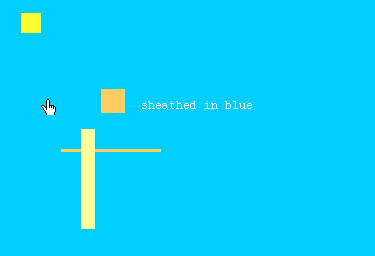
(part of) breathe
MCL: I agree with you that this medium acquires much of its fluidity from the fact that
we don't know the language very well, yet, and are always working in the inchoate. But I
was trying to get, too, at the fact that the blending or fusing of the media requires that
each of the elements be kept at (to mix metaphors) a kind of melting temperature--must
always be subject to change as the work proceeds. Do you find this?
RS: I have worked in very different ways and therefore the pieces on c.re.ation
have become very different. In "the shrIne" i had the text by Alan
Sondheim and the sound file by Annie Abrahams which are part on another project we and
some more artist are working on (not continiously) since one year. I didn't want to
'change' anything on the text or the spoken text and concentrated in bringing them
together with in a visual environment. In "vib~ratio~n" i had the
photos as material, the sound have been done inbetween or afterwards by Octavia Davis and
Bill Marsh on request. I could continue this ... with "breathe" (poem
by David Knoebel) or "desire" (text and music by Miekal And, sound by
Martha Cinader). In "water" it was different because Christy and myself
worked together for some months on the Net. When looking at my 'own' pieces the
method was/is another one.
For "e[y]gg[e]" i collected material and worked with it for appr. two
month. I prefer to create pools of material, photos, pictures, text parts and sounds. I am
'fixing' ideas in my sketchbook, sketches, thoughts, code fragments. With this material i
am 'cooking', but i am looking for, finding material also inbetween and the idea is
developing itself in the process. From the beginning i have an imagination which i want to
create, but this imagination is not concrete, maybe it is an imagination of an idea. Often
i can not explain verbally what i really want to realize but i 'know' what it will become.
The idea is cleared by the realization of itself in the medium or better the expression is
realized.
I do not know which way is 'harder' to go. To work with some 'fixed' stuff or to develop
an idea. In each process you have to smash some knots. I am never sure whether these knots
are imaginay or not. Sometimes i simply have to wait some days and the problem desolves or
i think "what a shit - there is no problem here - change your sight" (Re:).
Another time a solution appear by working on it. What is always helpful is, that "the
trash is your best friend" and that every mistake is a step of learning. To come back
to your question - my answer "yes, every part can flow" and "the
ingredients are unfolding their flavour".
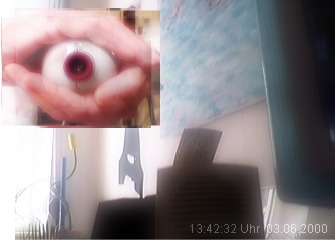
e[y]gg[e]
MCL: Going back to the earlier question, your emphasis on the transition is very
interesting. One thing that is always a bit frustrating about web work is that the
transitions that we do know how to do (between html pages) don't work very well
cross-browser. That means that the writer has to alert the reader in other ways that the
transition is important. There is always the recourse of opening new windows--and in
"breathe" you devised some fascinating ways. In terms of both time and
graphic effects, can you explain some of the formal issues in making the transitions
emphatic?
RS: As mentioned before i am looking at transitions as expressive tools. Thought in this
vein every kind of transition has his own 'meaning'. When a new window is opening, this is
a hard cut (emotional layer), which could ie. mean that a new aspect is brought in or
something else (metaphorical layer) - it depends on the environment where you use it.
These 'close window' statements are for novice viewers, children do not have any problem
opening and closing windows 'intuitively' after some short browser experience. In "breathe"
the idea was the 'combination' of an abstract picture, image with a poem (written by David
Knoebel) in the way that the image generates the poem and vice versa. Because the elements
are very different i used dhtml for the piece. Every picture element 'links/switches' to a
line. In such a way the image embraces the text. Because each part is activated by the
reader, s/he has the control over the speed. It depends on the time s/he needs to
read the text. S/he realises her/his individual rhythme.
MCL: Web art and literature are so new--you were one of the pioneers in 1997. Now, just a
few years later, there is a lively and diverse field being created. However, as bandwidth
improves, it will soon be possible to deliver full video and audio over the web. When that
occurs, how will Web Art and Literature distinguish itself from film? That is, if it is
possible to have full-motion graphics and a sound track--don't we now have a regular
movie?
RS: Well, we are at the border to the development you describe and there is the risc that
web art and literature will become nothing else than a short period around the millenium.
That it will be overwhelmed by the traditional kind of creation and perception. There have
been experiments with interactive film since the 80s. The examples i know developed as
teaching tools based on films with different story lines and linking to text (ie. a
dictionary). The hypertext and new media experiences of the last years have shown new
perspectives which should be continued. We should look at 'full video and audio' not as
competitors but try to implement these in hyperstructural pieces.
MCL: You said earlier that the "coincidence to the construction of a net art piece is
very fascinating for me"--. Coming from a multi-media background in the widest
sense, what aspect of Net Art do you find most challenging?
RS: Having made film in the 70s beside traditional art forms (drawing, painting), a
practicum at a theatre, written some short plays in the 90s, what is most challenging for
me is the fusion of these different media and the global 'space' in which you realize it
together with other artists/writers. What is also a 'lure' for me is the idea to create a
human counterpoint in this high tech medium/society.
c.re.ations
http://netartefact.de/repoem/creations/